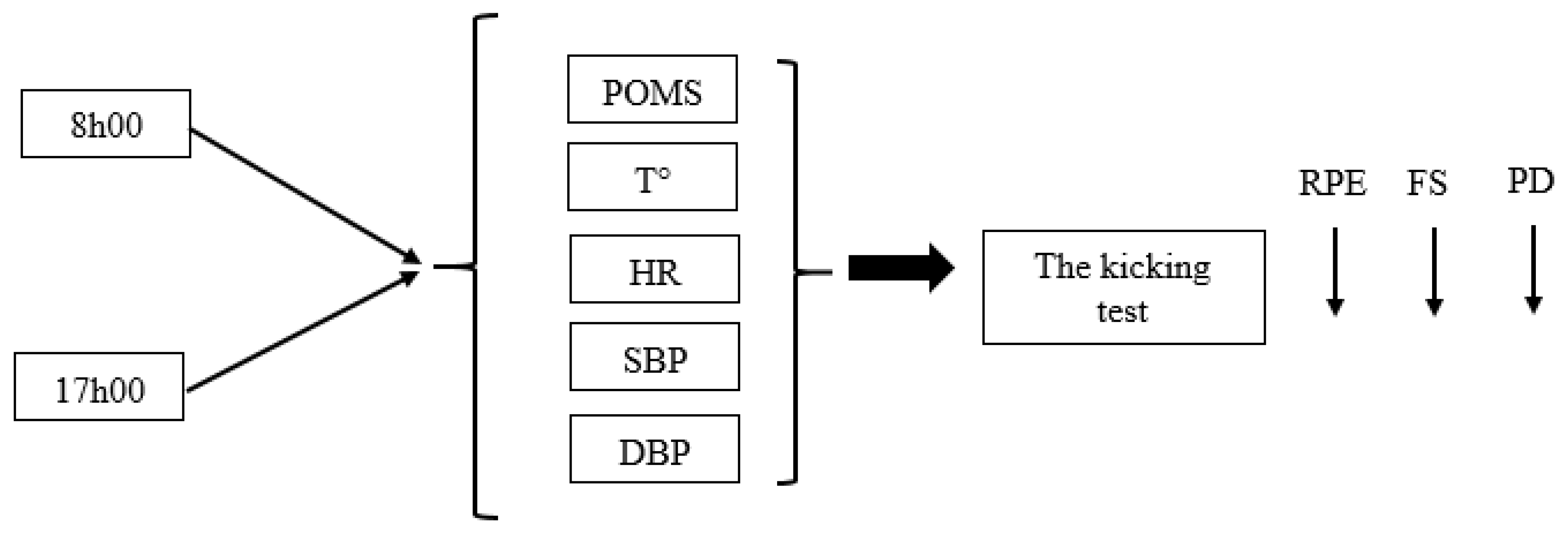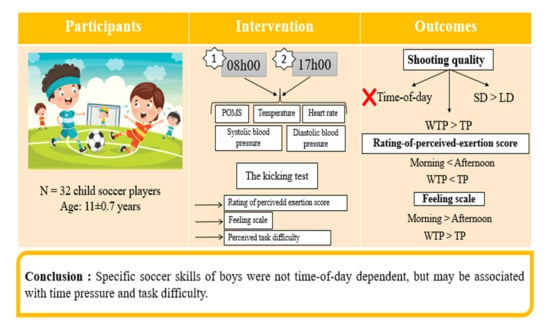The Effects of Exercise Difficulty and Time-of-Day on the Perception of the Task and Soccer Performance in Child Soccer Players
Abstract
1. Introduction
2. Materials and Methods
2.1. Participants
2.2. Procedure
2.3. Kicking Accuracy
2.4. Perceived Exertion Scale Rating
2.5. Feeling Scale
2.6. Perceived Difficulty
2.7. The Profile of Mood States (POMS)
2.8. Statistical Analysis
3. Results
3.1. Psychomotor Parameters
3.1.1. Kicking Accuracy
3.1.2. Kicking Velocity
3.2. Perceived Difficulty and Psychological Parameters
3.3. Physiological Parameters
4. Discussion
5. Strengths and Weaknesses
6. Conclusions
Author Contributions
Funding
Institutional Review Board Statement
Informed Consent Statement
Data Availability Statement
Conflicts of Interest
References
- Chtourou, H.; Souissi, N. The effect of training at a specific time of day: A review. J. Strength Cond. Res. 2012, 26, 1984–2005. [Google Scholar] [CrossRef]
- Chtourou, H.; Hammouda, O.; Souissi, H.; Chamari, K.; Chaouachi, A.; Souissi, N. Diurnal variations in physical performances related to football in adolescent soccer players. Asian J. Sports Med. 2012, 3, 139–144. [Google Scholar] [CrossRef]
- Souissi, H.; Chtourou, H.; Chaouachi, A.; Dogui, M.; Chamari, K.; Souissi, N.; Amri, M. The effect of training at a specific time-of-day on the diurnal variations of short-term exercise performances in 10-to 11-year-old boys. Pediatr. Exerc. Sci. 2012, 24, 84–99. [Google Scholar] [CrossRef]
- Gharbi, A.; Masmoudi, M.; Ghorbel, S.; Ben Saïd, N.; Maalej, R.; Tabka, T.; Zaouali, M. Time of Day Effect on Soccer-Specific Field Tests in Tunisian Boy Players. Adv. Phys. Educ. 2013, 3, 71–75. [Google Scholar] [CrossRef][Green Version]
- Chtourou, H.; Aloui, A.; Hammouda, O.; Souissi, N.; Chaouachi, A. Diurnal variation in long-and short-duration exercise performance and mood states in boys. Sport Sci. Health 2014, 10, 183–187. [Google Scholar] [CrossRef]
- Reilly, T.; Atkinson, G.; Edwards, B.; Waterhouse, J.; Farrelly, K. Diurnal variation in temperature, mental and physical performance, and tasks specifically related to football (soccer). Chronobiol. Int. 2007, 24, 507–519. [Google Scholar] [CrossRef]
- Cappaert, T.A. Time of day effect on athletic performance: An update. J. Strength Cond. Res. 1999, 13, 412–421. [Google Scholar] [CrossRef]
- Teo, W.; Newton, M.J.; McGuigan, M.R. Circadian rhythms in exercise performance: Implications for hormonal and muscular adaptation. J. Sports Sci. Med. 2011, 10, 600–606. [Google Scholar] [PubMed]
- Elghoul, Y.; Frikha, M.; Abdelmlak, S.; Chtourou, H.; Dammak, K.; Chamari, K.; Souissi, N. Time-of-day effect on dart-throwing performance and the perception of the difficulty of the task in 9–10 year-old boys. Biol. Rhythm. Res. 2014, 4, 523–532. [Google Scholar] [CrossRef]
- Elghoul, Y.; Frikha, M.; Masmoudi, L.; Chtourou, L.; Chaouachi, A.; Chamari, K.; Souissi, N. Diurnal variation of cognitive performance and perceived difficulty in dart-throwing performance in 9–10 year-old boys. Biol. Rhythm. Res. 2014, 5, 789–801. [Google Scholar] [CrossRef]
- Winget, C.M.; DeRoshia, C.W.; Holley, D.C. Circadian rhythms and athletic performance. Med. Sci. Sports Exerc. 1985, 17, 498–516. [Google Scholar] [CrossRef]
- Masmoudi, L.; Gharbi, A.; Chtourou, H.; Souissi, N. Effect of time-of-day on soccer specific skills in children: Psychological and physiological responses. Biol. Rhythm. Res. 2016, 47, 59–68. [Google Scholar] [CrossRef]
- Huguet, G.; Touitou, Y.; Reinberg, A. Diurnal changes in sport performance of 9- to 11-year-old school children. Chronobiol. Int. 1995, 14, 371–384. [Google Scholar] [CrossRef] [PubMed]
- Kim, J.; Chung, S.; Tennant, L.K.; Singer, R.N.; Janelle, C.M. Minimizing error in measurement of error: A proposed method for calculation of error in a two-dimensional motor task. Percept. Mot. Skills 2000, 90, 253–261. [Google Scholar] [CrossRef] [PubMed]
- Kubayi, A. Analysis of goal scoring patterns in the 2018 FIFA World Cup. J. Hum. Kinet. 2020, 71, 205. [Google Scholar] [CrossRef]
- Tsaousidis, N.; Zatsiorsky, V. Two types of ball-effector interaction and their relative contribution to soccer kicking. Hum. Mov. Sci. 1996, 15, 861–876. [Google Scholar] [CrossRef]
- Missenard, O.; Fernandez, L. Moving faster while preserving accuracy. Neuroscience 2011, 197, 233–241. [Google Scholar] [CrossRef]
- Fitts, P.M.; Deininger, R.L. SR compatibility: Correspondence among paired elements within stimulus and response codes. J. Exp. Psychol. 1954, 48, 483. [Google Scholar] [CrossRef]
- Van den Tillaar, R.; Ulvik, A. Influence of instruction on velocity and accuracy in soccer kicking of experienced soccer players. J. Mot. Behav. 2014, 46, 287–291. [Google Scholar] [CrossRef]
- Frikha, M.; Derbel, M.S.; Chaâri, N.; Gharbi, A.; Chamari, K. Acute effect of stretching modalities on global coordination and kicking accuracy in 12-13 year-old soccer players. Hum. Mov. Sci. 2017, 54, 63–72. [Google Scholar] [CrossRef]
- Reilly, T.; Farrelly, K.; Edwards, B.; Waterhouse, J. Effects of time of day on the performance of soccer-specific motor skills. In Science and Football V; Reilly, T., Cabri, J., Araujo, D., Eds.; Routledge: London, UK, 2004; pp. 272–274. [Google Scholar]
- Tanner, J.M. Growth at Adolescence, 2nd ed.; Blackwell Science: Oxford, UK, 1962. [Google Scholar]
- Finnoff, J.T.; Newcomer, K.; Laskowski, E.R. A valid and reliable method for measuring the kicking accuracy of soccer players. J. Sci. Med. Sport 2002, 5, 348–353. [Google Scholar] [CrossRef]
- Foster, C.; Florhaug, J.A.; Franklin, J.; Gottschall, L.; Hrovatin, L.A.; Parker, S. A new approach to monitoring exercise training. J. Strength Cond. Res. 2001, 15, 109–115. [Google Scholar] [PubMed]
- Hardy, C.J.; Rejeski, W.J. Not what, but how one feels: The measurement of affect during exercise. J. Sport Exerc. Psychol. 1989, 11, 304–317. [Google Scholar] [CrossRef]
- Delignières, D.; Famose, J.P.; Thépaut-Mathieu, C.; Fleurance, P. A psychophysical study on difficulty ratings in rock climbing. Int. J. Sports Psychol. 1993, 24, 404–416. [Google Scholar]
- McNair, D.M. Profile of mood states instrument. In Manual for the Profile of Mood States; Educational and Industrial Testing Service: San Diego, CA, USA, 1971; pp. 3–29. [Google Scholar]
- Faul, F.; Erdfelder, E.; Lang, A.G.; Buchner, A. GPower 3: A flexible statistical power analysis program for the social, behavioral, and biomedical sciences. Behav. Res. Methods 2007, 39, 175–191. [Google Scholar] [CrossRef]
- Bernard, T.; Giacomoni, M.; Gavarry, O.; Seymat, M.; Falgairette, G. Time-of-day effects in maximal anaerobic leg exercise. Eur J. Appl. Physiol. Occup. Physiol. 1998, 77, 133–138. [Google Scholar] [CrossRef] [PubMed]
- Souissi, H.; Chaouachi, A.; Chamari, K.; Dogui, M.; Amri, M.; Souissi, N. Time-of-day effects on short-term exercise performances in 10–11-years-old Boys. Pediatric. Exerc. Sci. 2010, 22, 613–623. [Google Scholar] [CrossRef]


| Variable | WTP | TP | |||
|---|---|---|---|---|---|
| SD | LD | SD | LD | ||
| Absolute error (cm) | 08:00 h | 53.5 ± 12.7 | 79.1 ± 12.5 1 | 67.9 ± 13.6 2 | 93.3 ± 10.3 1,2 |
| 17:00 h | 53.8 ± 13.2 | 76.8 ± 14.3 1 | 65.9 ± 16.8 2 | 91.8 ± 10.5 1,2 | |
| Variable error (cm) | 08:00 h | 47.9 ± 12 | 67.1 ± 13.7 1 | 50.1 ± 13.1 | 71.9 ± 13.3 1 |
| 17:00 h | 50.7 ± 13.7 | 67.7 ± 14.4 1 | 52.1 ± 17.2 | 72.4 ± 11.3 1 | |
| Constant error (cm) | 08:00 h | 19.6 ± 14.8 | 27.7 ± 16.4 | 22.5 ± 16.1 | 29.1 ± 15.5 |
| 17:00 h | 18.7 ± 12.6 | 28.7 ± 14.9 | 21 ± 9.1 | 32 ± 17.3 1 | |
| Ball velocity (m/s) | 08:00 h | 9.6 ± 1.3 | 10.5 ± 1.7 1 | 8.7 ± 1.2 | 9.1 ± 1.4 |
| 17:00 h | 9.6 ± 1.4 | 10.5 ± 1.6 1 | 8.7 ± 1.7 | 9.2 ± 1.3 | |
| Shooting quality (m/s) | 08:00 h | 1.06 ± 0.25 | 0.43 ± 0.14 1 | 0,75 ± 0.22 2 | 0.24 ± 0.1 1,2 |
| 17:00 h | 0.85 ± 0.22 | 0.8 ± 0.17 1 | 0.96 ± 0.29 2 | 0.84 ± 0.14 1,2 | |
| Perceived difficulty (A.U) | 08:00 h | 4.84 ± 2.33 | 6.31 ± 1.97 1 | 5.03 ± 2.61 | 5.81 ± 2.31 1 |
| 17:00 h | 5.56 ± 2.68 | 6.47 ± 2.63 | 4.75 ± 2.37 | 7.03 ± 2.75 1 | |
| Feeling score (A.U) | 08:00 h | 2.19 ± 2.62 | 2.28 ± 1.53 | 3.16 ± 1.92 2 | 3.34 ± 2.22 2 |
| 17:00 h | 3.19 ± 1.8 3 | 2.09 ± 1.49 1 | 2.69 ± 1.71 | 0.63 ± 1.68 1,2,3 | |
| RPE (A.U) | 08:00 h | 1.0 ± 1.02 | 1.16 ± 0.88 1 | 0.78 ± 1.16 | 1.63 ± 1.62 1 |
| 17:00 h | 1.03 ± 1.18 | 1.34 ± 0.6 | 1.5 ± 1.34 3 | 2.16 ± 1.14 2,3 | |
| Variable | 08:00 h | 17:00 h | t-Test | p-Value |
|---|---|---|---|---|
| Anxiety (A.U) | 2.6 ± 3.1 | 3.2 ± 3.7 | 0.69 | 0.496 |
| Anger (A.U) | 5.5 ± 4 | 5 ± 5.2 | 0.43 | 0.669 |
| Confusion (A.U) | 2.1 ± 3.7 | 2 ± 2.2 | 0.12 | 0.905 |
| Depression (A.U) | 1.6 ± 2.1 | 3.1 ± 4.2 | 2.47 | 0.019 |
| Fatigue (A.U) | 2.3 ± 2.7 | 2.3 ± 3.2 | 0.06 | 0.955 |
| Vigor (A.U) | 26 ± 4.3 | 28.1 ± 4.2 | 2.19 | 0.036 |
| Interpersonal-Relationship (A.U) | 23.1 ± 5 | 23.3 ± 4.4 | 0.12 | 0.908 |
| TMD (A.U) | −12.1 ± 11.8 | −12.5 ± 18.2 | 0.13 | 0.896 |
| Variable | 08:00 h | 17:00 h | t-Test | p-Value |
|---|---|---|---|---|
| Temperature (°C) | 35 ± 0.8 | 36.2 ± 0.5 | 7.46 | <0.001 |
| HR (b·min−1) | 84 ± 9 | 88 ± 11 | 2.26 | 0.031 |
| SBP (mmHg) | 11.4 ± 0.7 | 11.5 ± 1.1 | 0.21 | 0.833 |
| DBP (mmHg) | 6.5 ± 0.7 | 6.6 ± 1.2 | 0.33 | 0.741 |
Publisher’s Note: MDPI stays neutral with regard to jurisdictional claims in published maps and institutional affiliations. |
© 2021 by the authors. Licensee MDPI, Basel, Switzerland. This article is an open access article distributed under the terms and conditions of the Creative Commons Attribution (CC BY) license (https://creativecommons.org/licenses/by/4.0/).
Share and Cite
Masmoudi, L.; Gharbi, A.; H’Mida, C.; Trabelsi, K.; Boukhris, O.; Chtourou, H.; Bouzid, M.A.; Clark, C.C.T.; Souissi, N.; Rosemann, T.; et al. The Effects of Exercise Difficulty and Time-of-Day on the Perception of the Task and Soccer Performance in Child Soccer Players. Children 2021, 8, 793. https://doi.org/10.3390/children8090793
Masmoudi L, Gharbi A, H’Mida C, Trabelsi K, Boukhris O, Chtourou H, Bouzid MA, Clark CCT, Souissi N, Rosemann T, et al. The Effects of Exercise Difficulty and Time-of-Day on the Perception of the Task and Soccer Performance in Child Soccer Players. Children. 2021; 8(9):793. https://doi.org/10.3390/children8090793
Chicago/Turabian StyleMasmoudi, Liwa, Adnene Gharbi, Cyrine H’Mida, Khaled Trabelsi, Omar Boukhris, Hamdi Chtourou, Mohamed Amine Bouzid, Cain C. T. Clark, Nizar Souissi, Thomas Rosemann, and et al. 2021. "The Effects of Exercise Difficulty and Time-of-Day on the Perception of the Task and Soccer Performance in Child Soccer Players" Children 8, no. 9: 793. https://doi.org/10.3390/children8090793
APA StyleMasmoudi, L., Gharbi, A., H’Mida, C., Trabelsi, K., Boukhris, O., Chtourou, H., Bouzid, M. A., Clark, C. C. T., Souissi, N., Rosemann, T., & Knechtle, B. (2021). The Effects of Exercise Difficulty and Time-of-Day on the Perception of the Task and Soccer Performance in Child Soccer Players. Children, 8(9), 793. https://doi.org/10.3390/children8090793











